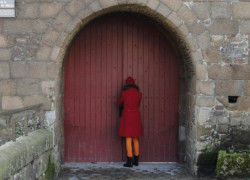
Words by Brianna Bullen
Melbourne is listed as one of UNESCO’s seven Cities of Literature, one with a remarkable literary culture. This remarkable literary culture is reflected in this year’s Fringe festival’s new category: ‘Words and Ideas.’ Supported by UNESCO’s ‘Open Book’ program, writer and live artist Georgia Symons discusses her Melbourne Fringe “one on book” experience, the dystopically titled You Must Come Alone to Read the Last Book On Earth.
The title formed first, generating the questions that created the show. “What would be in the last book on earth? Why would people have to come alone? And what could possibly happen to the world that would lead to the extinction of all books?” Motivated by the current climate of uncertainty surrounding the idea that books are “dying out” and loss of arts funding, Symons does not fall into the nihilism of the era and instead forces us to confront our uncomfortable relationships with books in the present with an attitude of tentative hope. “I think the world would have to go to a very, very dark place if all books were to go extinct,” she explains. “But this book is an allegory for our attitudes—in Australia in particular—towards storytelling, books and arts. All of us – even most artists—have been trained from a young age to see the arts as secondary; a luxury to be indulged in once the essentials have been taken care of.”
Symons links this with white Australia’s “uncomfortable relationship” to its past. For Symons, storytelling is the best method for confronting its atrocities, with storytelling the best tool for “making decisions for our future based on the best possible knowledge of our present and past. When we put storytelling on the backburner and delete the uncomfortable parts of our history, we endanger ourselves gravely as a society and, I believe, as a species.”
Symons has spent a lifetime reading, writing, and celebrating books: from humble beginnings as a primary school library monitor (mastering the Dewey decimal system) through to publication at eighteen. However, it was at the 2014 Arts House’s Festival of Live Art, when she encountered the term ‘live art’ for the first time, that she found her calling. “As soon as I encountered this form, I knew it was something that resonated with the kind of work I wanted to offer to people. Live art has many definitions, but for me it’s about the specific curation of a live experience, borrowing from any and all other forms of art in order to deliver something very specific, live and present.”
Embodiment and the interaction between the very physical reader in a very physical space, is crucial to ‘feeling’ art for Symons. “The kind of book you want to read as quickly as you can in amongst the hustle and bustle of public transport and the CBD is very different from the kind of book for which you barricade yourself in your bedroom and build a fort of sheets. We all have bodies and they are always present in space when we experience art.”
This is Symons “first time creating a book myself—from commissioning the binding through to writing the content and transcribing it [by hand!]” Working closely with the Melbourne School of Bookbinding to create a book “made to look as though it was cobbled together by someone with expert knowledge but only the roughest of scraps at their disposal” Symons jokes: “I will probably never be able to buy an off-the-shelf notebook again in my life!”
The book produced depends on audience participation, and is inspired by John Berger’s quote: “never again will a single story be told as though it were the only one.” Symons firmly believes that “even if there was only one person left, there would be more than one story. If there were no people left, the stories would still be written in the fabric of reality.”

